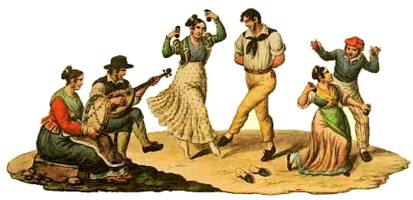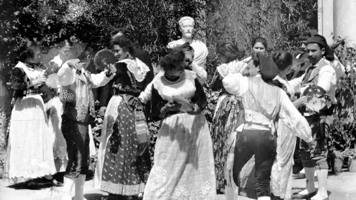
|
Folk Dance Federation of California, South, Inc.
|

|
CLICK AN IMAGE TO ENLARGE
All regions of Italy< have their folklore, that finds expression in the dance. Dances such as the Saltarello and the Tarantella, true national folk dances of Italy, are known throughout the world.
Modern dancing is popular, even in the most remote villages of Italy, especially among young people, but folk dances are still remembered and often practiced. The style originates in ancient local traditions and attendant folklore is handed down from generation to generation.
Several of the folk dances of northern Italy are famous throughout the world. To Liguria belongs the dance Ballon. In this dance the woman's skirt swells out during the "pirola" (pirouette), as in the Waltz. When the woman pirouettes, with arms above her head, the movement makes the skirt swell and rise, giving an illusion of a flight. The Prigordin originally was introduced to the Lunigiana region from France. It is usually danced at a wedding or at the ceremony of a baptism. The Farandola, too, is a Ligurian dance. It is danced by moonlight in open fields around a hay effigy of a bull. It is a derivation from the medieval Carola. The Farandola also is danced to music of bagpipes around bonfires at carnival time on the Ligurian beaches. In Genoa, it is called theRiunda.
The Corrente, a well known folk dance of Piedmont, originated in the 16th century, when Italian actors introduced it to France. The name is derived from Correntoni, the firey Piedmontese peasants, who are described as wild as the mountain torrents of their native province. Originally, it was a very lively dance; then it became slower and more solemn, although in country dances it has kept its vivacity. The Minuet is derived from it. Another Piedmontese folk dance is the Gigueo. Of Italian origin, it won fame abroad. The French word "giguer" means to dance; while in England the Jig is a sailors' dance. The Claquette, a dance in which the feet are stamped, is derived from a Scottish Gigue. In its original form, the Gigue is danced a weddings with the Lachera. This is in the form of a mock wedding ceremony and procession of guests called "Lecheri."
The Monferrina, one of the most famous of the old dances, originated in Piedmont, particularly the Monferrato region. It is of the Bacchic inspiration. The Nizzarda is of Provenyal origin, but in the past it was danced in Piedmont.
From Lombardy comes theBergamasca. In its original form the Bergamasca entailed difficult somersaulting. It has undergone a change. The man now approaches the woman, takes four steps and bows, removes his hat, and extends his hand to her. Then, to return to his place, he takes two steps and makes a turn, followed by four further steps. There are many variations of this dance. It is practiced in Romagna, among other places, and is known as the hat dance.
 In the Venetia region, the most famous dance is the Furlana, or the Friulana, the dance of the Friuli region. It is one of the ancient mimed dances, taking the form of a lovers' quarrel. Variations of the Furlana, that greatly resembles the Tarantella, are danced in Calabria, Romagna, and Emilia. This country dance won popularity in the city where it became the Cotillion and the Quadrille. Other dances of the Venetian provinces include the Lavandera (washerwoman's dance), and the Girometta.
In the Venetia region, the most famous dance is the Furlana, or the Friulana, the dance of the Friuli region. It is one of the ancient mimed dances, taking the form of a lovers' quarrel. Variations of the Furlana, that greatly resembles the Tarantella, are danced in Calabria, Romagna, and Emilia. This country dance won popularity in the city where it became the Cotillion and the Quadrille. Other dances of the Venetian provinces include the Lavandera (washerwoman's dance), and the Girometta.
The Torotele (flower dance) is famous in the Friuli region. A dance with many couples, it also takes the form of a lovers' quarrel, in which the woman, holding the flower, threatens the man, who strikes the floor with a sharp blow of the foot.
The renowned Volta, of medieval origin, is still danced in Pieve di Cadore and is believed to be the dance from which the Waltz originated. The Volta was danced by a couple who, in turning, had to remain close together. The woman's right hand was on her partner's neck, while with her left she gathered her skirt as in the Waltz. The man's left hand was on the woman's hip, while with his right hand he assisted her to leap, left thigh against her right, giving firm support. A variant of the Volta was the Tirolese in 3/4 meter with accent on the first beat. This dance, devised later than the Volta, is nearest to the Waltz. The dancers, as in the Waltz, circle the room.
The Rescana is danced in Gorizia, usually during Epiphany. It is called a fire dance because it is danced around bonfires in open country or on a hill top, with the youths leaping through the flames. La Danza del Ventaglio (fan dance), spread from Venice to other Italian cities. During this dance the woman chooses her partner, giving her fan in token.
Many of the folk dances in central Italy have been adapted or modified from the more widespread dances of northern and southern Italy.
Dances typical of Emilia and Roagna are the I Quattro Cantoni (four corners) danced with four men and five women; the Ballo della Torcia (torch dance) or Dei Moccoli (candles) or Delle Lanterne (lanterns) was danced while accompanying guests home at night; the Ballo del Fiore (flower dance), and the Scapigliato, which is acrobatic and is a severe test of endurance.
The Tresche or Tresca of Tuscany is described as a manner of dancing with the hands and feet. This dance is one in which the whole village joins. The dancers, in a chain, weave through the streets and squares of the village. A derivative of the Tresca is the Trescone, still often danced today and very popular throughout Italy.
In the regions of Marche and Umbria the dances are variations of those danced in Rome of the Ciociara region. The Saltarello is danced on the toes, while the Galloppa of Marche is an imitation of horse galloping.
The typical dance of Latium is the famous Saltarello, that has become a national dance, and, together with the Neoopolitan Tarantella is one of the Italian folk dances of world-wide fame.
In Abruzzi there is a dance at Teramo called Laccio d'Amore (love knot). The men offer their right hands to the women beating tambourines. From a central pole hangs a ribbon for each dancer, usually twenty-four in number. The dancers must skillfully braid the ribbins and end with a Saltarello.
In southern Italy, Sicily and Sardinia, the Tarantella is the most poplular of folk dances. It is a very ancient folk dance and has many variations The title is derived from the word "tarantula" and originally the dance was in imitation of the contortions of a person bitten by the tarantula. According to Noccolo Perotti, "the women would come running in crowds and they would contract the malady, which was not so much the bite of the poisonous insect as it was in the moral poison which they greedily drank with their eyes." The Tarantelle were accompanied by wind instruments, mostly clarinets, and the rhythm of the tambourine. The men rotated a club or sword above their heads, while the women "with passionate gestures and utter forgetfulness of feminine modesty abandoned themselves to an excitement of the senses." Thus, the Tarantella is picturesque, imaginative, inspirational, and full of folklore.
In the province of Naples, the Tarantella is the most popular dance. In Posillipo and Capri, the old Tarantella is danced to the music of bagpipes and cymbals. From a slow dragging start, the rhythm increases until the music becomes very fast and almost vertiginous. Anton Giulio Bragaglia described it as a dance of "outright delirium which possesses everyone. The tarantula, the poisonous spider, has bitten the heel of those frenetic dancers."
In Sicily, the Ruggero is still in style. Originally, it was a round, and was named as such because the feet of the dancers move clockwise or counterclockwise, and the pattern of the movements is likened to the wheels of a watch.
In Sardinia, The Duroduro (Sardinian round dance) has a chain of dancers, weaving serpent-like, winding and unwinding continually. The rigidity of the dancers, arms unmoving, close to the body, is characteristic.
The above are the most famous of the Italian folk dances. Not all are danced as they were originally. Some have become a memory, while others have lost their spontaneity, as a result of modern adaptation. In the essential character, all these dances remain the basis of folk traditions, and are an expression of the creative artistry of the Italian people.
Printed in Let's Dance!, October 1962.